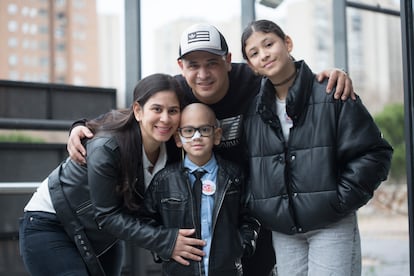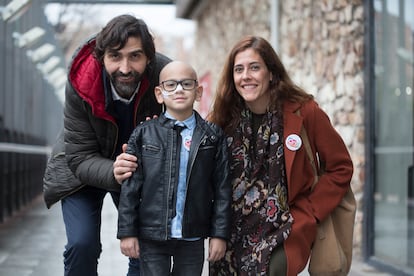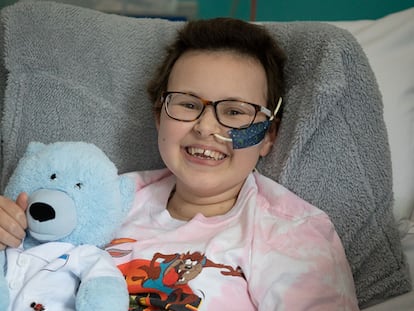Here’s how little Mathías beat his cancer: From no hope to a cure in one month
An oncological experimental applied therapy, thanks to the CRIS Foundation, brought about remission in the case of a seven-year-old boy whose alternative was palliative care

Mathías — seven years old, with his bald head, wearing doubled-up masks to protect him from infections — plays with a sticker book while his oncologist proudly displays her phone: “Look, you don’t need to be a doctor to understand this.” She shows a scan from the end of last December, where a black spot can clearly be seen, a secondary tumor from a leukemia that had beaten all approved treatments and had led the boy to be admitted to hospice care. In the next image, a scan from a month later in which the spot has disappeared, thanks to an experimental treatment.
Just a few years ago, this would have sounded like wishful thinking, and Mathías would have had no hope. His treatment-resistant leukemia left him part of the 15% of patients who did not see results after chemotherapy or a bone marrow transplant. But chances in cases like those of Mathías are getting better all the time, thanks to the latest generation of cellular treatments, known as CAR-T.
At first, Mathías’ small body was resistant even to these revolutionary solutions. After a bone marrow transplant from his sister, he was infused (inoculated) with cells that cause his immune system to destroy the malignant cells. But his cancer reappeared, in the form of a solid tumor. That is “very rare,” in the words of one of his oncologists, Antonio Pérez, who is director of the CRIS unit of advanced treatments at Madrid’s La Paz Hospital, where the experimental treatment has been developed, thanks to funding from the CRIS Cancer Foundation, which focuses its work on childhood leukemia.
The treatment he then received, which is also based on CAR-T, has not yet been approved, and was applied only through what is called compassionate use, the prescription of drugs that have not yet been approved for patients who no longer have any other hope. It goes a step further than the treatments that are normally used: it attacks not one, but two molecules in cancer cells, the CD19 and CD22. Pérez is graphic in his description of the process: “Imagine that the cell is a person. The CAR-Ts grab them by one arm to take them out. With this treatment, which we call a tandem, it grabs them by one arm and one ear, so they can’t escape.” That way, even if tumors are obscuring one of the molecules, the treatment will still work. Mathías was infused with the cells on December 29. In a month, his tumor had disappeared.
Hospitals have become an inseparable part of his life. His Venezuelan parents, Yessenia Chacón and Wiston Rivas, received the diagnosis in their country, when the little boy was just 10 months old. He was suffering from acute lymphoblastic leukemia type B. Mathías needed a bone marrow transplant, which could not be done in Venezuela. So, the family started a crowdfunding campaign to come to Spain. “Relatives, friends and a very famous person helped us, so we got the money and we came,” says his mother.

His parents left their jobs as firefighter and nurse, and came to Spain to treat their son. They initially came to the Sant Joan de Deu Hospital in Barcelona. There, Mathías’ sister Paola had her bone marrow extracted — she was five years old and barely remembers the process — and it was introduced into Mathías’ body. But he suffered relapses, and not even the CAR-T, which lead to improvements in 85% of children (which come from the 15% of kids for whom other treatments have failed) were able to cure him.
“Today, when you arrive at that point, there is no other option. Either palliative care or you enter a clinical trial,” says Pérez. Chacón says that at the time, doctors at Madrid’s Gregorio Marañón Hospital, where he was being treated at the time, said that they were going to look for an alternative: “That is when they decided that he was a candidate for this treatment. They told us that it was difficult, but that we had to try, that it was possible. And we were always very optimistic.”
The treatment was developed in a public hospital, with doctors from the public system, but fully financed by the CRIS Cancer Foundation, which since 2018 has invested more than $7.6 million in the CRIS unit for advanced treatments, where it has helped to treat more than 886 children with a variety of illnesses and tumors. Mathías’ treatment is now waiting on various bureaucratic processes to be able to begin a clinical trial that will allow it to be applied to younger patients, and not have to wait to be designated as compassionate use.
To date, the procedure has been tried on nine children, of whom six are still alive, encouraging numbers that will soon be published in a scientific journal. The remission of Mathías’ tumor has been one of its success stories, and probably its most spectacular triumph. But the process is not over yet. “We know that if we do nothing, the cancer comes back. Here we have a chance, which experience tells lasts 100 days to four months, and during that time we have to consolidate and perform a second transplant. In order to do that, there can’t be any traces left of the disease,” says Chacón.
New patients
There’s already a date for the second transplant: February 29, in the Gregorio Marañón, where Mathías was previously treated. The little boy has begun a series of pre-op tests, the likes of which he is well-accustomed-to at this point. “He doesn’t know how serious his illness is, but he understands perfectly what it consists of, and its treatments,” says his mother, while the little boy opts to continue playing with his sticker boy rather than talk to a journalist.
During his periods of hospitalization, Mathías did not even miss school time. At the Marañón, a teacher oversaw his daily schoolwork. “Everything but English, because she doesn’t know it,” he clarifies, before continuing to play.
If everything goes well, after three to six months, Mathías will be able to have a normal life. With luck, his leukemia will become a distant memory. “People who get transplants, even those who have had two transplants, when they get past the critical phase, begin to construct a life that is like that of any other child of the same age. They estimate that there are a half million childhood leukemia survivors in Europe,” says Pérez.
The doctors’ team hope to get this treatment approved, and to popularize the CAR-T as a first-choice treatment in order to avoid more aggressive approaches: “Chemotherapy is from the last century. We are in the 21st century now, and this is what we should be using, only we are lacking resources,” says Pérez. The CAR-Ts that have been developed in the private sphere are incredibly expensive. The first treatment that Mathías received cost around $538,000. But initiatives like this one, which can be administered in public hospitals, drastically reduce price tags.
Sign up for our weekly newsletter to get more English-language news coverage from EL PAÍS USA Edition
Tu suscripción se está usando en otro dispositivo
¿Quieres añadir otro usuario a tu suscripción?
Si continúas leyendo en este dispositivo, no se podrá leer en el otro.
FlechaTu suscripción se está usando en otro dispositivo y solo puedes acceder a EL PAÍS desde un dispositivo a la vez.
Si quieres compartir tu cuenta, cambia tu suscripción a la modalidad Premium, así podrás añadir otro usuario. Cada uno accederá con su propia cuenta de email, lo que os permitirá personalizar vuestra experiencia en EL PAÍS.
¿Tienes una suscripción de empresa? Accede aquí para contratar más cuentas.
En el caso de no saber quién está usando tu cuenta, te recomendamos cambiar tu contraseña aquí.
Si decides continuar compartiendo tu cuenta, este mensaje se mostrará en tu dispositivo y en el de la otra persona que está usando tu cuenta de forma indefinida, afectando a tu experiencia de lectura. Puedes consultar aquí los términos y condiciones de la suscripción digital.
More information
Archived In
Últimas noticias
Most viewed
- Sinaloa Cartel war is taking its toll on Los Chapitos
- Oona Chaplin: ‘I told James Cameron that I was living in a treehouse and starting a permaculture project with a friend’
- Reinhard Genzel, Nobel laureate in physics: ‘One-minute videos will never give you the truth’
- Why the price of coffee has skyrocketed: from Brazilian plantations to specialty coffee houses
- Silver prices are going crazy: This is what’s fueling the rally










































